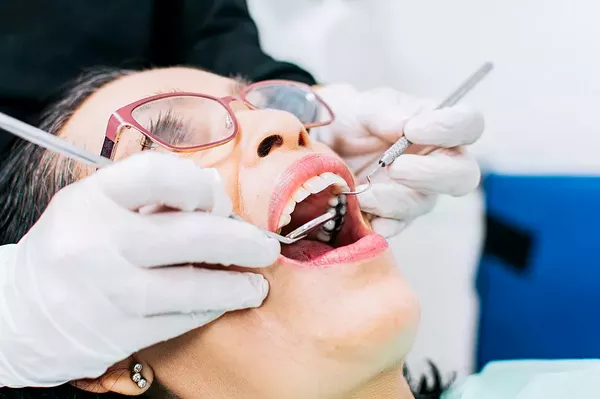Dental implants have revolutionized modern dentistry by providing a durable and natural-looking solution for replacing missing teeth. Unlike traditional dentures or bridges, dental implants offer a permanent replacement that closely mimics the appearance and function of natural teeth. If you’re considering dental implants, you may wonder how they look in the mouth and how they blend with your existing teeth. In this article, we will delve into the visual aspects of dental implants, their appearance, and the factors that contribute to a seamless integration with your smile.
Understanding Dental Implants
Dental implants are titanium posts surgically placed into the jawbone to serve as artificial tooth roots. These posts fuse with the bone over time in a process called osseointegration, creating a strong foundation for the attachment of replacement teeth.
Natural-Looking Appearance
Dental implants are designed to closely replicate the appearance of natural teeth. Several factors contribute to their natural-looking appearance:
Customization:Dental implants can be customized to match the shape, size, and color of your natural teeth. This ensures a seamless integration with your existing smile.
Crown Design:The visible part of the dental implant, known as the crown, is carefully crafted to resemble a real tooth. Dental professionals take into account factors such as tooth shape, shade, and alignment to create a lifelike crown.
Blending with Existing Teeth:One of the key advantages of dental implants is their ability to blend seamlessly with your existing teeth. Factors that contribute to this seamless integration include:
Color Matching:Dental professionals use a shade guide to select the color of the crown that closely matches your natural teeth. This ensures that the implant crown does not stand out from the rest of your smile.
Positioning:Dental implants are strategically placed to ensure that they align with adjacent teeth. This careful positioning contributes to a harmonious and balanced smile.
Proportions:The size and proportions of the implant crown are tailored to match the adjacent teeth, ensuring a consistent and balanced appearance.
Gingival Integration:The gums, or gingiva, play a crucial role in the overall appearance of dental implants:
Gum Contouring:Dental professionals sculpt the gum tissue around the implant to create a natural gumline that complements the adjacent teeth.
Healthy Appearance:Well-maintained gum tissue around dental implants enhances their overall aesthetic by providing a healthy and natural frame.
Visual Transition:The transition between the dental implant and the natural tooth is carefully managed to create a seamless look:
Transitional Shape:The contour and shape of the implant crown transition naturally to the adjacent teeth, eliminating any abrupt edges or irregularities.
Texture and Shine:Dental professionals ensure that the texture and shine of the implant crown match those of natural teeth, creating a cohesive appearance.
Smile Enhancement:Dental implants not only restore the appearance of missing teeth but can also enhance your smile in various ways:
Improved Confidence:Dental implants provide a confident smile, eliminating self-consciousness about gaps or missing teeth.
Facial Structure:Implants help maintain facial structure by preventing bone loss that can occur when teeth are missing.
Functionality:Dental implants allow for normal eating, speaking, and biting, just like natural teeth.
Professional Guidance:When considering dental implants, seeking the expertise of a qualified dental professional is crucial:
What is an arch in dental implants
In the context of dental implants, an “arch” refers to a specific arrangement of dental implants used to support a full set of replacement teeth, also known as a full arch restoration. A full arch restoration involves replacing all of the teeth in either the upper or lower jaw, or sometimes both jaws, with a set of prosthetic teeth supported by dental implants.
The term “arch” comes from the dental anatomy, where the upper and lower sets of teeth are organized in an arch-like configuration. In the case of dental implants, a full arch restoration involves the placement of a certain number of dental implants in an arch formation to provide stability and support for the prosthetic teeth.
Implant Placement:
Dental implants are surgically placed into the jawbone. The number of implants required for a full arch restoration can vary depending on factors such as bone density, bone quality, and the type of restoration being used.
Abutments:
Once the implants have integrated with the jawbone (a process known as osseointegration), abutments are attached to the implants. Abutments are connector pieces that protrude from the gums and serve as anchors for the prosthetic teeth.
Prosthetic Teeth:
The prosthetic teeth, also known as implant-supported dentures or bridges, are custom-made to closely resemble natural teeth. They are attached to the abutments and are securely held in place by the dental implants.
Benefits of an Implant Arch:
Stability: The use of multiple implants provides a stable foundation for the prosthetic teeth, allowing for improved biting and chewing capabilities.
Aesthetics: Implant-supported restorations closely resemble natural teeth, enhancing the appearance of the smile and face.
Bone Preservation: Dental implants stimulate the jawbone, preventing bone loss that commonly occurs when teeth are missing.
Confidence: Implant-supported prosthetic teeth are secure and do not shift or move, providing a greater sense of confidence when speaking and eating.
Types of Full Arch Restorations:
There are different types of full arch restorations, including:
All-on-4: This technique uses four strategically placed implants to support a full arch of prosthetic teeth. It is designed to provide stability even in cases of limited bone volume.
All-on-6: Similar to All-on-4, this approach uses six implants for added support and stability.
Fixed Dentures: Implant-supported fixed dentures are permanently attached to the implants and can only be removed by a dentist. They offer a natural appearance and improved function.
Implant-Supported Bridge: This option involves placing multiple implants to support a fixed bridge that replaces several missing teeth.
What are the advantages of dental implants
Dental implants are a revolutionary solution for replacing missing teeth, offering numerous advantages that make them a preferred choice for many patients. Here are some of the key advantages of dental implants:
Natural-Looking and Feeling:Dental implants closely resemble natural teeth in terms of appearance and function. They are custom-designed to match the color, shape, and size of your existing teeth, creating a seamless and natural smile.
Improved Chewing and Speaking:Dental implants provide strong and stable support for replacement teeth, allowing you to bite and chew with confidence. Unlike traditional dentures, implants won’t slip or shift, enhancing your ability to eat a wide variety of foods.
Long-Term Solution:With proper care and maintenance, dental implants have the potential to last a lifetime. This longevity makes them a cost-effective option in the long run, as they may not need to be replaced as frequently as other dental restorations.
Preservation of Bone Health:When a tooth is lost, the underlying jawbone can start to deteriorate over time due to lack of stimulation. Dental implants mimic natural tooth roots, stimulating the jawbone and preventing bone loss. This helps maintain facial structure and prevents the sunken appearance that can occur with missing teeth.
Preservation of Adjacent Teeth:Traditional tooth-supported bridges require the reduction of adjacent healthy teeth to support the bridge. Dental implants, on the other hand, do not require alteration of neighboring teeth, preserving their natural structure.
Enhanced Confidence and Self-Esteem:Dental implants provide a permanent and secure solution that can greatly boost your confidence. You can speak, smile, and eat without worrying about your replacement teeth moving or falling out.
Improved Oral Hygiene:Dental implants do not require special cleaning techniques or adhesives. You can maintain your oral hygiene routine by brushing, flossing, and visiting your dentist for regular check-ups, just as you would with natural teeth.
Comfort and Convenience:Dental implants become a part of your mouth, eliminating the discomfort often associated with removable dentures. There’s no need to remove them for cleaning or worry about them slipping out of place.
No Dietary Restrictions:Unlike dentures, which may require avoiding certain foods, dental implants allow you to enjoy your favorite foods without restriction. You can bite into crunchy apples or chewy steaks with confidence.
Prevention of Shifting Teeth:Gaps left by missing teeth can lead to neighboring teeth shifting into the empty spaces, causing misalignment. Dental implants fill these gaps, helping to maintain proper tooth alignment.
Predictable and Successful Outcome:Dental implant procedures have a high success rate when performed by skilled professionals. Advances in implant technology and techniques contribute to the predictability of the treatment’s outcome.
Support for Facial Aesthetics:By preserving bone health and facial structure, dental implants contribute to a more youthful appearance, as they help prevent the sunken cheeks and sagging skin that can occur with missing teeth.
Customization:
Dental professionals will customize the implant crown to match your natural teeth and create a harmonious smile.
Expertise:
Qualified dental professionals have the expertise to ensure a successful implant placement and natural-looking outcome.
Conclusion
Dental implants offer a natural-looking and aesthetically pleasing solution for replacing missing teeth. Their appearance closely resembles that of natural teeth, thanks to careful customization, color matching, positioning, and gingival integration. The seamless blend with existing teeth, along with their ability to enhance your smile and restore functionality, makes dental implants a popular choice in modern dentistry. By seeking professional guidance and opting for dental implants, you can enjoy a confident and radiant smile that not only looks natural but also improves your overall oral health and quality of life.
Related Topics:































